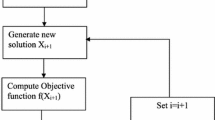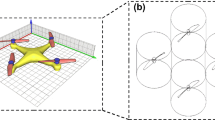Abstract
The enhancement of the early design stages, in the production of aeronautical engines, has been shown decisive, for developing efficient and reliable final products. Nevertheless, in most of industrial engineering design problems, the amount of design variables is large. Moreover, several nonlinearities characterize the behaviour of the physical phenomena involved and the derivatives are seldom known for all the functions. Besides, objective functions exhibit several local extremes, whereas the designer as well as the practitioner is usually interested in the global one. In this context, stochastic and evolutionary optimization have been shown capable to provide reliable solutions while keeping the computational cost at a reasonable level. Existing tools for the design and optimization of engine components deal with the optimal and detailed design of specific engine components, thus requiring several computational time and efforts to gain optimized design parameters. Hence, existing tools fit for later design phases. Conversely, this paper proposes an integrated design and optimization environment, for automatically designing optimal aeronautical piston engine configuration, still in the conceptual design stage. The optimization is performed using the MATLAB genetic algorithm (GA) toolbox®, while the automatic design of the optimized components is carried out in cascade to the optimization phase. In particular, a single-objective GA is used to evaluate the optimal dimensions of engine components related to motion, namely: crankshaft, connecting rods and screws, flywheel, propeller shaft and torsional vibration damper. For testing the efficiency of the integrated environment, the conceptual design of components of a 4-in-line Diesel aeronautical piston engine is proposed, starting from an existing similar engine. Results show a reduction of the 20 % of weight of the crankshaft in comparison to the original configuration. The proposed environment seems to be a promising tool for a fast and reliable conceptual design of piston engines for aeronautical purposes.
Similar content being viewed by others
References
Goldberg DE (1991) Genetic algorithms as a computational theory of conceptual design. In: Applications of artificial intelligence in engineering VI. Springer, Netherlands, pp 3–16
Bentley PJ, Wakefield JP (1997) Conceptual evolutionary design by a genetic algorithm. Eng Des Autom 3:119–132
Rao SS, Rao SS (2009) Engineering optimization: theory and practice. Wiley
Renzi C, Leali F, Cavazzuti M, Andrisano AO (2014) A review on artificial intelligence applications to the optimal design of dedicated and reconfigurable manufacturing systems. Int J Adv Manuf Technol 72(1–4):403–418
Andersson J (2000) A survey of multiobjective optimization in engineering design. Department of Mechanical Engineering, Linkoping University, Linkoping, Sweden, Technical Report No: LiTH-IKP
Fonseca CM, Fleming PJ (1993) Genetic algorithms for multiobjective optimization: formulation discussion and generalization. In ICGA 93:416–423
Adl AH, Panahi MS (2010) Multi-objective optimal design of a passenger car’s body. In: ASME 2010 10th Biennial Conference on Engineering Systems Design and Analysis. American Society of Mechanical Engineers, pp. 277–286
Ali N, Behdinan K (2003) Optimal geometrical design of aircraft using genetic algorithms. Trans Can Soc Mech Eng 26(4):373–388
Buonanno M, Mavris D (2004) Small supersonic transport concept evaluation using interactive evolutionary algorithms. In: Collection of Technical Papers-AIAA 4th Aviation Technology, Integration, and Operations Forum, ATIO. 1:411–426
Ceruti A, Caligiana G, Persiani F (2013) Comparative evaluation of different optimization methodologies for the design of UAVs having shape obtained by hot wire cutting techniques. Int J Interact Des Manuf 7(2):63–78
Ceruti A (2013) Design and heuristic optimization of low temperature differential stirling engine for water pumping 2013. Int J Heat Technol 31:9–16
Lee KK, Lee KH, Woo ET, Han SH (2014) Optimization process for concept design of tactical missiles by using pareto front and TOPSIS. Int J Precis Eng Manuf 15(7):1371–1376
Li J, Wu J, Yan S (2013) Conceptual design of deployment structure of morphing nose cone. Advances in Mechanical Engineering 5:590957
Ng TTH, Leng GSB (2007) Design of small-scale quadrotor unmanned air vehicles using genetic algorithms. Proceedings of the Institution of Mechanical Engineers, part G. J Aerosp Eng 221(5):893–905
Wang P, Wu G (2013) Multidisciplinary design optimization of vehicle instrument panel based on multi-objective genetic algorithm. Chin J Mech Eng Sci 26(2):304–312
Annicchiarico W, Cerrolaza M (2004) A 3D boundary element optimization approach based on genetic algorithms and surface modeling. Eng Anal Boundary Elem 28(11):1351–1361
Albers A, Leon-Rovira N, Aguayo H, Maier T (2009) Development of an engine crankshaft in a framework of computer-aided innovation. Comput Ind 60(8):604–612
Fujita K, Hirokawa N, Akagi S, Kitamura S, Yokohata H (1998) Multi-objective optimal design of automotive engine using genetic algorithm. Power 200(150):100
Huang HZ, Bo RF, Fan XF (2005) Concept optimization for mechanical product using genetic algorithm. J Mech Sci Technol 19(5):1072–1079
Ma SL, Li FY, He Y, Xu QZ (2012) Multidisciplinary design optimization of driving axle housing using sparse grid approach. Applied Mechanics and Materials 224:82–86
Wang WL, Yang XJ, Xu GX, Huang Y (2011) Multi-objective design optimization of the complete valve system in an adjustable linear hydraulic damper. Proceedings of the Institution of Mechanical Engineers, part C. J Mech Eng Sci 225(3):679–699
Wu Z, Campbell MI, Fernández BR (2008) Bond graph based automated modeling for computer-aided design of dynamic systems. J Mech Des 130(4):041102
Yang XH, Zhu YP, Wang J, Kang Y (2014) Product form modular design based on genetic algorithm. Applied Mechanics and Materials 568:835–841
D'Souza B, Simpson TW (2003) A genetic algorithm based method for product family design optimization. Eng Optim 35(1):1–18
Hao B, Wang LX (2005) The research of the optimal innovative design technology of the hierarchical structure products based on genetic algorithms. In Robotics and Biomimetics (ROBIO). 2005 I.E. International Conference on IEEE. pp. 576–580
Liu DT, Jia FF (2014) A method of the green product configuration design based on multi-layer generalized operator and genetic algorithm. Applied Mechanics and Materials 483:542–549
Valliyappan S, Simpson TW (2006) Exploring visualization strategies to support product family design optimization. In: 11th AIAA/ISSMO Multidisciplinary Analysis and Optimization Conference. pp. 6–8
Wie X, Zhao T, Ju Z, Zhang S, Li X (2011) Multi-objective optimization conceptual design of product structure based on variable length gene expression. Chin J Mech Eng Sci 24(1):42
Zhou C, Lin Z, Liu C (2008) Customer-driven product configuration optimization for assemble-to-order manufacturing enterprises. Int J Adv Manuf Technol 38(1–2):185–194
Muscia R, Russo S (2000) A methodology for preliminary crankshafts design. Proceeding of the 7th International Conference on Industrial Engineering and Engineering Management (IE & EM 2000), Guangzhou
Albers A, Leon N, Aguayo H, Maier T (2008) Multi-objective system optimization of engine crankshafts using an integration approach. In: ASME 2008 International Mechanical Engineering Congress and Exposition. American Society. pp. 101–109
Patel P, Shah P, Mourelatos ZP (2010) Piston design using multi-objective reliability-based design optimization (No. 2010-01-0907). SAE Technical Paper.
Zhu J, Xi PY (2010) Intelligent design of internal combustion engine in hybrid genetic algorithm. Applied Mechanics and Materials 26–28:186–189
Zottin W, Cuco APC, dos Reis MVF, da Silva RFA (2008) Application of optimization techniques in the design of engine components (No. 2008-01-0219). SAE Technical Paper
Ghorbanian J, Ahmadi M, Soltani R (2011) Design predictive tool and optimization of journal bearing using neural network model and multi-objective genetic algorithm. Scientia Iranica 18(5):1095–1105
Russo R, Clarich A, Carriglio M (2012) A multi-objective optimization of engine crankshaft design using modeFRONTIER. International Review of Mechanical Engineering 6(3)
Tembhurkar C, Kamble P (2009) Computer aided design and analysis of air engine piston. Emerging Trends in Engineering and Technology (ICETET) 2009:92–97
Liu Y, Tian H, Ding X, Liu L, Qiu T (2010) Research on 3-D design for the group of piston crankshaft connecting rod. Int Conf Meas Technol Mechatron Autom 2010:3–6
Liu Y, Yang J, Sun J (2011) Study on 3-D computer aided design for the small bore directed-injection engine combustion system, 704–706
Chipperfield AJ, Fleming PJ (1995) The MATLAB genetic algorithm toolbox. In Applied control techniques using MATLAB, IEE Colloquium on IET. pp. 10–1
Shygley JE, Mischke CR, Budynas RG (2003) Mechanical engineering design, McGraw Hill
Kollbrunner C F, Meister M (2013) Knicken, Biegedrillknicken, Kippen: Theorie und Berechnung von Knickstäben Knickvorschriften. Springer-Verlag
Meirovitch L (1997) Principles and techniques of vibrations, vol 1. Prentice Hall, New Jersey
Nestorides EJ (1958) A handbook on torsional vibration. Cambridge University Press
Charkha PG, Jaju SB (2009) Analysis & optimization of connecting rod. 2009 Second International Conference on Emerging Trends in Engineering & Technology 2009:86–91. doi:10.1109/ICETET.2009.30
Liu XZ, Hu J (2004) Concurrent and collaborative modeling for automotive engine design. In Computer Supported Cooperative Work in Design, 2004. Proceedings. The 8th International Conference on IEEE. 2:51–55
Tseng KC, El-Ganzoury W (2012) An intelligent system based on concurrent engineering for innovative product design at the conceptual design stage. Int J Adv Manuf Technol 63(5–8):421–447
Author information
Authors and Affiliations
Corresponding author
Rights and permissions
About this article
Cite this article
Renzi, C. A genetic algorithm-based integrated design environment for the preliminary design and optimization of aeronautical piston engine components. Int J Adv Manuf Technol 86, 3365–3381 (2016). https://doi.org/10.1007/s00170-016-8433-7
Received:
Accepted:
Published:
Issue Date:
DOI: https://doi.org/10.1007/s00170-016-8433-7




